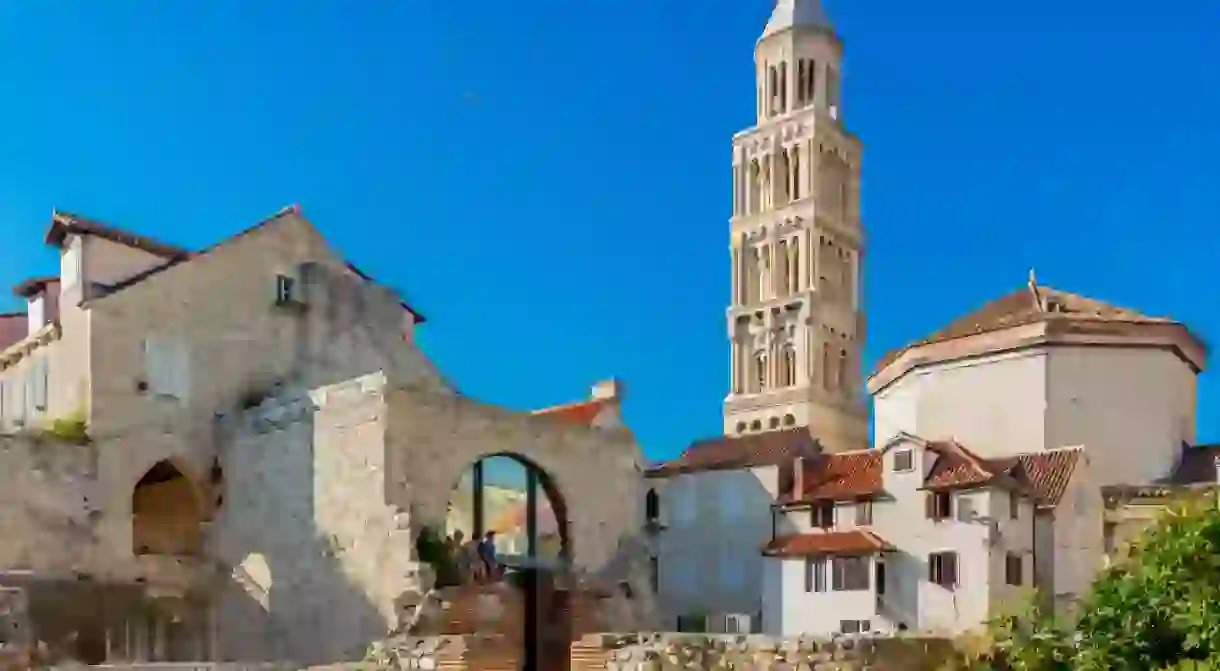The 20 Must-Visit Attractions in Split, Croatia

Its heart comprised of the major historical sight of Diocletian’s Palace, Split contains a scattering of mainly old-school museums. You’ll also find striking statuary by Ivan Meštrović, whose villa is a must-see gallery. Other attractions include two busy markets, a hidden synagogue and a cathedral once built for a Roman emperor.
Split City Museum
Museum

Temple of Jupiter
Historical Landmark
The cathedral baptistery, down a narrow passageway opposite the church itself, is worth investigating for the ornate carvings you’ll find within. Originally a Roman temple to Jupiter, with a likeness of Apollo still visible above one portal, the baptistery contains an 11th-century font that displays a relief of Croatian King Zvonimir.
Marko Marulic Statue
Historical Landmark
Created by Ivan Meštrović, the statue of Split-born Renaissance poet Marko Marulić centrepieces Trg Braće Radić, the square known as Voćni trg as it once housed the fruit market. Captured mid-stanza, Marulić is known for his Latin-language treatise on psychology but more revered for his Croatian poetry.
Archaeological Museum
Museum
Sv Frane Church & Monastery
Historical Landmark

Built by Franciscan monks on the site of an early Christian church, Sv Frane contains the tomb of the St Felicia from the time of Diocletian and a crucifix by 15th-century master Blaž Jurjev Trogiranin. In the adjoining cloister, a library is lined with 3,000 works dating back to the 1500s.
Riva
Historical Landmark
Running between the Diocletian’s Palace and the sea, the café-lined Riva is the city’s communal meeting place. Officially named Obala Hrvatskog narodnog preporoda (‘Waterfront of the Croatian National Revival’), the Riva was landscaped by Napoleonic ruler Marshal Marmont. Revamped in 2007, the Riva hosts prominent cultural events and celebrations.
Fish market
Historical Landmark
Known by locals as the Peškarija, Split’s fish market has been in place since the late 1800s. Comprising an indoor hall and a outdoor space giving out onto pedestrianised Marmontova, the fish market purveys all kinds of seafood, from baracudas to squid to shellfish. Browsing is an education in itself.
Bačvice
Natural Feature
Split’s urban beach of Bačvice, near the harbour and bus station, comprises a half-moon of sand bookended by bars and cafés at each end. In the shallows, locals engage in boisterous games of picigin, outdoing each other to hit a rubber ball in artistic fashion.
Diocletian’s Palace
Building

Kaštelet
Museum, Art Gallery, Historical Landmark
Split Synagogue
Historical Landmark
Hidden away in a passageway off Bosanska in Diocletian’s Palace, the synagogue is one of the oldest still active in Europe. Set on the second floor across adjoining medieval houses, with a tasteful interior dating to the early 1700s, the synagogue is open to visitors whenever ceremonies aren’t taking place.
Monument to Gregory of Nin
Historical Landmark
Designed by Ivan Meštrović, the statue of Grgur Ninski stands outside the Golden Gate of Diocletian’s Palace. With his finger pointing and clasping a book, this dramatic figure is part of the urban fabric. No-one knows why, but touching the big toe of this early medieval cleric is said to bring good luck.
Ethnographic Museum
Cathedral, Museum, School

Gallery of Fine Arts
Museum, Art Gallery
Meštrović Gallery
Building, Park
Cathedral of Saint Domnius, Split
Cathedral

Croatian National Theatre in Split
Building
Museum of Croatian Archaeological Monuments
Historical Landmark
Once housed in a monastery in Knin, the Museum of Croatian Archaeological Monuments occupies a former barracks near the Meštrović Gallery. Only a quarter of the 20,000-strong collection is on display, focusing mainly on ecclesiastical carvings, jewellery and weapons, created by and for Croats around 800-1100AD.
Split Market
Market
Pretty much a 24-hour operation, setting up before dawn, its bars filled until late evening, Split’s market lines the eastern flank of Diocletian’s Palace. Amid the piles of fresh fruit and vegetables, you’ll find honeys, olive oils and various home-made spirits, as well as towels and accoutrements for the beach.
Croatian Maritime Museum
Museum













